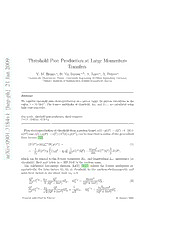
Threshold Pion Production at Large Momentum Transfers PDF
Preview Threshold Pion Production at Large Momentum Transfers
9 Threshold Pion Production at Large Momentum 0 0 Transfers 2 n V. M. Brauna, D. Yu. Ivanova,b, A. Lenza, A. Petersa a J aInstitut fu¨r Theoretische Physik, Universit¨atRegensburg, D-93040 Regensburg, Germany bSobolev Institute of Mathematics, 630090 Novosibirsk, Russia 1 2 ] h p Abstract - p We consider threshold pion electroproduction on a proton target for photon virtualities in the e region 1−10 GeV2. The S-wave multipoles at threshold, E0+ and L0+, are calculated using h light-cone sum rules. [ 1 v Key words: thresholdpionproduction, chiralsymmetry 4 PACS: 13.60.Le,12.38.Lg 8 1 3 Pionelectroproductionatthresholdfromaprotontarget,e(l)+p(P) e(l′)+π+(k)+ 1. n(P′)ande(l)+p(P) e(l′)+π0(k)+p(P′),canbedescribedintermso→ftwogeneralised 0 → form factors [1,2] 9 0 v: hN(P′)π(k)|jµem(0)|p(P)i= (1) Xi =−fi N¯(P′)γ5(cid:26) γµq2−qµ6q m12Gπ1N(Q2)− iσ2µmνqνGπ2N(Q2)(cid:27)N(P), r π (cid:0) (cid:1) a which can be related to the S-wave transverse E0+ and longitudinal L0+ multipoles (at threshold). Here and below m=939 MeV is the nucleon mass. The celebrated low-energy theorem (LET) [3,4,5] relates the S-wave multipoles or, equivalently, the form factors G1,G2 at threshold, to the nucleon electromagnetic and axial form factors in the chiral limit m =0 π Q2Gπ0p= gA Q2 Gp , Gπ0p = 2gAm2 Gp , (2) m2 1 2 (Q2+2m2) M 2 (Q2+2m2) E Q2Gπ+n= gA Q2 Gn + 1 G , Gπ+n = 2√2gAm2 Gn . m2 1 √2(Q2+2m2) M √2 A 2 (Q2+2m2) E PreprintsubmittedtoElsevier 22January2009 Here the terms inG aredue to pionemissionoff the initial protonstate, whereasfor M,E charged pion in addition there is a contribution corresponding to the chiral rotation of the electromagnetic current [3]. The subsequent discussion concentrated mainly on the corrections to (2) due to finite pion mass [6,7]. More recently,the threshold pion productionfor small Q2 wasreconsid- eredandthe low-energytheoremsre-derivedinthe frameworkofthe chiralperturbation theory(CHPT), see [8] fora review.The new insightgainedfromCHPT calculations[9] is that the expansion at small Q2 has to be done with care as the limits m 0 and π Q2 0donotcommute,ingeneral.The LETpredictionsseemtobe ingoodag→reement → withexperimentaldataonpionphotoproduction[10],However,itappears[11,8]thatthe S-wave electroproduction cross section for already Q2 0.1 GeV2 cannot be explained ∼ without taking into account chiral loops. Forlargermomentumtransfersthesituationismuchlessstudiedasthepowercounting ofCHPTcannotbe applied.The traditionalderivationofLETusingPCACandcurrent algebra does not seem to be affected as long as the emitted pion is ’soft’ with respect to the initial and final state nucleons simultaneously. The corresponding condition is, parametrically, Q2 Λ3/m (see, e.g. [6]) where Λ is some hadronic scale, and might π be satisfied for Q2 ≪1 GeV2 or evenhigher. We are not awareofany dedicatedanalysis of the threshold pr∼oduction in the Q2 1 GeV2 region, however. ∼ It was suggested[12] that in the limit of very large momentum transfers the standard pQCD collinear factorisation approach becomes applicable and the helicity-conserving GπN form factor can be calculated for m = 0 in terms of chirally rotated nucleon 1 π distribution amplitudes. In practice one expects that the onset of the pQCD regime is postponed to very large momentum transfers because the factorisable contribution involvesasmallfactorα2(Q)/π2andhastowinovernonperturbative“soft”contributions s that are suppressed by an extra power of Q2 but do not involve small coefficients. The purpose of this study is to suggest a realistic QCD-motivated model for the Q2 dependence of the G1,2 form factors alias S-wave multipoles at threshold in the region Q2 1 10 GeV2 that can be accessible in current and future experiments in Jefferson ∼ − Laboratoryandelsewhere(HERMES,MAMI).InRef.[13]wehavedevelopedatechnique to calculate baryon form factors for moderately large Q2 using light-cone sum rules (LCSR). This approach is attractive because in LCSRs “soft” contributions to the form factors are calculated in terms of the same nucleon distribution amplitudes (DAs) that enterthepQCDcalculationandthereisnodoublecounting.Thus,theLCSRsprovideone withthemostdirectrelationofthehadronformfactorsanddistributionamplitudesthat is available at present, with no other nonperturbative parameters. The same technique can be applied to pion electroproduction, taking into account the semi-disconnected pion-nucleon contributions in the intermediate state. In Refs. [1,2] the G1 and G2 form factors are estimated in the LCSR approachfor the range of momentum transfers Q2 1 10GeV2.WedemonstratethattheLETresultsin(2)areindeedreproducedatQ2 ∼ 1−GeV2 to the required accuracy (m ), whereas the pQCD contribution considere∼d π in [12] formally corresponds to theOleading (at large Q2) part of the NNLO radiative correction (α2) to the sum rules. Hence our approach describes both high-Q2 and low-Q2 lim∼itsOcorrsectly and presents an extrapolation in between that makes maximal use of quark-hadronduality and dispersion relations. Accurate quantitative predictions are difficult for severalreasons,e,g,because the nu- cleon distribution amplitudes are poorly known.In order to minimise the dependence of 2 0.5 0.6 0.4 0.4 0.3 0.2 0.2 0.1 E0π+0p/GD 0 E0π++n/GD 0 −0.1 −0.2 0 2 4 6 8 10 0 2 4 6 8 10 Q2 Q2 0.05 0.4 0 0.2 −0.05 −0.1 0 −0.15 −−00..225 L0π+0p/GD −0.2 Lπ0++n/GD −0.3 −0.4 0 2 4 6 8 10 0 2 4 6 8 10 Q2 Q2 Fig.1.Thetree-levelLCSRresults(curves)comparedtoMAID07[14](points)fortheQ2dependenceof theelectricandlongitudinal partialwaves atthreshold, E0+ andL0+ (inunits ofGeV−1),normalised tothedipoleformula. various parameters one may use the LCSRs to predict certain form factor ratios only, and then normalise to the electromagnetic nucleon form factors as measured in the ex- periment, see [2] for the details. The results are shown by the solid curves in Fig. 1, where the four partial waves at threshold are plotted as a function of Q2, normalised to the dipole formula G (Q2) = 1/(1+Q2/µ2)2 where µ2 = 0.71 GeV2. To give a rough D 0 0 idea about possible uncertainties, the “pure” LCSR predictions (all form factors and other input taken from the sum rules) are shown by dashed curves for comparison. The accuracy can be improved in future and requires calculation of radiative corrections to theLCSRs,especiallyifsufficientlypreciselatticecalculationsofthemomentsofnucleon distribution amplitudes become available. References [1] V.M.Braun,D.Yu.Ivanov, A.LenzandA.Peters,Phys.Rev.D75,014021 (2007). [2] V.M.Braun,D.Yu.IvanovandA.Peters,Phys.Rev.D77,034016(2008). [3] N.M.KrollandM.A.Ruderman,Phys.Rev.93,233(1954). [4] Y.NambuandD.Lurie,Phys.Rev.125,1429(1962). [5] Y.NambuandE.Shrauner,Phys.Rev.128,862(1962). [6] A.I.VainshteinandV.I.Zakharov, Nucl.Phys.B36,589(1972). [7] S.SchererandJ.H.Koch,Nucl.Phys.A534,461(1991). [8] V.Bernard,N.KaiserandU.G.Meissner,Int.J.Mod.Phys.E4,193(1995). [9] V.Bernard,N.KaiserandU.G.Meissner,Phys.Rev.Lett.69,1877(1992). [10] D.DrechselandL.Tiator,J.Phys.G18,449(1992). [11] V.Bernard,N.Kaiser,T.S.H.LeeandU.G.Meissner,Phys.Rev.Lett. 70,387(1993). [12] P.V.Pobylitsa,M.V.PolyakovandM.Strikman,Phys.Rev.Lett.87(2001) 022001. [13] V. M. Braun, A. Lenz, N. Mahnke and E. Stein, Phys. Rev. D 65, 074011 (2002); V. M. Braun, A.LenzandM.Wittmann, Phys.Rev.D73,094019(2006). 3 [14] D.Drechsel,S.S.KamalovandL.Tiator,Eur.Phys.J.A34,69(2007). 4
